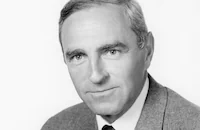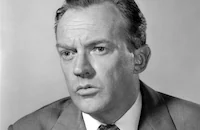KATY JURADO, 1924 - 2002
Katy Jurado, an Oscar nominee and major actress in Westerns, died July 5th at the age of 78. She was born in Guadalajara, Mexico on January 16th 1924 as Maria Cristina Estella Marcela Jurado Garcia, daughter of a cattle rancher and an opera singer. Jurado started to appear in Mexican films in 1943. After 15 films in her native country, director Budd Boetticher saw Jurado attending a bullfight (Jurado wrote about the subject for Mexican newspapers) and cast her in his Bullfighter and the Lady (1952), her Hollywood debut. For much of her career Jurado alternated between the two film industries. In the US, she was memorable for the sensual energy she brought to roles in High Noon (1952), One-Eyed Jacks (1961) which was directed by Marlon Brando, Sam Peckinpah's Pat Garrett and Billy the Kid (1973) and John Huston's Under the Volcano (1984). She was nominated for an Oscar as Best Supporting Actress for Broken Lance (1954). Jurado's Mexican films were in a broader range of genres and included Luis Bunuel's El Bruto (1952), Ismael Rodriguez's We the Poor and Miguel Littin's The Widow Montiel (1979). She won three Ariel Awards (Mexican equivalent to the Oscars) and one special award. She was married to Ernest Borgnine from the end of 1959 to summer 1963. One of her final films was The Hi-Lo Country (1998), a contemporary Western directed by Stephen Frears and co-starring Woody Harrelson, Billy Crudup and Penelope Cruz.
by Lang Thompson
DOLORES GRAY, 1924 - 2002
Broadway and nightclub star Dolores Gray died June 26th at the age of 78. Her movie career was brief but consisted of high-profile MGM musicals which guaranteed her a place in film history. Gray was born in Chicago on June 7th, 1924 (and where, according to a common story, she was accidentally shot by a gangster as a child and had a bullet in her lung her entire life). As a teenager she began singing in California until Rudy Vallee featured her on his radio show. Gray moved to Broadway in 1944 and then to the London stage in 1947, solidifying her reputation as a singer/actress while constantly giving the gossip columnists plenty to write about. She had two small singing roles in Lady for a Night (1941) and Mr. Skeffington (1944) but didn't really light up the big screen until It's Always Fair Weather (1955) even though Gray reportedly didn't much care for the role. Her rendition of "Thanks a Lot, But No Thanks," which has her gunning down a slew of male dancers on-stage and kicking them through trap doors, is a genuine showstopper. Three more unforgettable musical roles quickly followed: Kismet (1955), The Opposite Sex (1956, which Gray turned down Funny Face to do) and Designing Women (1957). That was it for Gray's film career. She kept busy with TV appearances (mostly singing though she did one 1988 episode of the cult show Dr. Who) and a busy recording and nightclub schedule. In 1987, she appeared in a British production of Follies at Stephen Sondheim's request.
by Lang Thompson
ROD STEIGER, 1925 - 2002
From the docks of New York to the rural back roads of Mississippi to the war torn Russian steppes, Rod Steiger reveled in creating some of the most overpowering and difficult men on the screen. He could be a total scoundrel, embodying Machiavelli's idiom that "it's better to be feared than loved" in the movies. But as an actor he refused to be typecast and his wide range included characters who were secretly tormented (The Pawnbroker, 1965) or loners (Run of the Arrow, 1965) or eccentrics (The Loved One, 1965).
Along with Marlon Brando, Steiger helped bring the 'Method School' from the Group Theater and Actors Studio in New York to the screens of Hollywood. The Method technique, taught by Stella Adler and Lee Strasberg, insisted on complete immersion into the character's psyche and resulted in intense, dramatic performances and performers. Steiger made his first significant screen appearance as Brando's older brother in On the Waterfront (1954). Their climatic scene together in a taxicab is one of the great moments in American cinema.
It was a short leap from playing a crooked lawyer in On the Waterfront to playing the shady boxing promoter in The Harder They Fall (1956). Based on the tragic tale of true-life fighter Primo Carnera, The Harder They Fall details the corruption behind the scenes of professional boxing bouts. Steiger is a fight manager named Nick Benko who enlists newspaperman Eddie Willis (Humphrey Bogart in his final screen appearance) to drum up publicity for a fixed prizefight. While the boxing scenes were often brutally realistic, the most powerful dramatic moments took place between Steiger and Bogart on the sidelines.
As mob boss Al Capone (1959), Steiger got to play another man you loved to hate. He vividly depicted the criminal from his swaggering early days to his pathetic demise from syphilis. In Doctor Zhivago (1965), Steiger was the only American in the international cast, playing the hateful and perverse Komarovsky. During the production of Dr. Zhivago, Steiger often found himself at odds with director David Lean. Schooled in the British tradition, Lean valued the integrity of the script and demanded that actors remain faithful to the script. Steiger, on the other hand, relied on improvisation and spontaneity. When kissing the lovely Lara (played by Julie Christie), Steiger jammed his tongue into Christie's mouth to produce the desired reaction - disgust. It worked! While it might not have been Lean's approach, it brought a grittier edge to the prestige production and made Komarovsky is a detestable but truly memorable figure.
Steiger dared audiences to dislike him. As the smalltown southern Sheriff Gillespie in In The Heat of the Night (1967), Steiger embodied all the prejudices and suspicions of a racist. When a black northern lawyer, played by Sidney Poitier, arrives on the crime scene, Gillespie is forced to recognize his fellow man as an equal despite skin color. Here, Steiger's character started as a bigot and developed into a better man. He finally claimed a Best Actor Academy Award for his performance as Sheriff Gillespie.
Steiger was an actor's actor. A chameleon who didn't think twice about diving into challenging roles that others would shy away from. In the Private Screenings interview he did with host Robert Osborne he admitted that Paul Muni was one of his idols because of his total immersion into his roles. Steiger said, "I believe actors are supposed to create different human beings." And Steiger showed us a rich and diverse cross section of them.
by Jeremy Geltzer & Jeff Stafford































